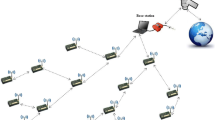
Overview
- Focuses on non-cryptographic attacks that cannot easily be addressed by using traditional methods, but are critical for developing secure wireless systems
Access this book
Tax calculation will be finalised at checkout
Other ways to access
About this book
Securing Emerging Wireless Systems: Lower-layer Approaches aims to fill a growing need in the research community for a reference that describes the lower-layer approaches as a foundation towards secure and reliable wireless systems. Whereas most of the references typically address cryptographic attacks by using conventional "network security" approches for securing wireless systems, the proposed book will be differentiated from the rest of the market by its focus on non-cryptographic attacks that cannot easily be addressed by using traditional methods, and further by presenting a collection of defense mechanisms that operate at the lower-layers of the protocol stack and can defend wireless systems before the effects of attacks propagate up to higher-level applications and services.
The book will focus on fundamental security problems that involve properties unique to wireless systems, such as the characteristics of radio propagation, or the location of communicating entities, or the properties of the medium access control layer. Specifically, the book provides detection mechanisms and highlights defense strategies that cope with threats to wireless localization infrastructure, attacks on wireless networks that exploit entity identity (i.e. spoofing attacks), jamming and radio interference that can undermine the availability of wireless communications, and privacy threats where an adversary seeks to infer spatial and temporal contextual information surrounding wireless communications. Additionally, the authors explore new paradigms of physical layer security for wireless systems, which can support authentication and confidentiality services by exploiting fading properties unique to wireless communications.
Similar content being viewed by others
Keywords
Table of contents (16 chapters)
-
Front Matter
-
Defending Against Wireless Spoofing Attacks
-
Front Matter
-
-
Preserving Privacy in Wireless Networks
-
Front Matter
-
Authors and Affiliations
Accessibility Information
Bibliographic Information
Book Title: Securing Emerging Wireless Systems
Book Subtitle: Lower-layer Approaches
Authors: Yingying Chen, Wenyuan Xu, Wade Trappe, YanYong Zhang
DOI: https://doi.org/10.1007/978-0-387-88491-2
Publisher: Springer New York, NY
eBook Packages: Engineering, Engineering (R0)
Copyright Information: Springer-Verlag US 2009
Hardcover ISBN: 978-0-387-88490-5Published: 26 November 2008
Softcover ISBN: 978-1-4419-4693-5Published: 05 November 2010
eBook ISBN: 978-0-387-88491-2Published: 13 November 2008
Edition Number: 1
Number of Pages: XVIII, 362
Number of Illustrations: 50 b/w illustrations
Topics: Communications Engineering, Networks, Signal, Image and Speech Processing, Data Structures and Information Theory



